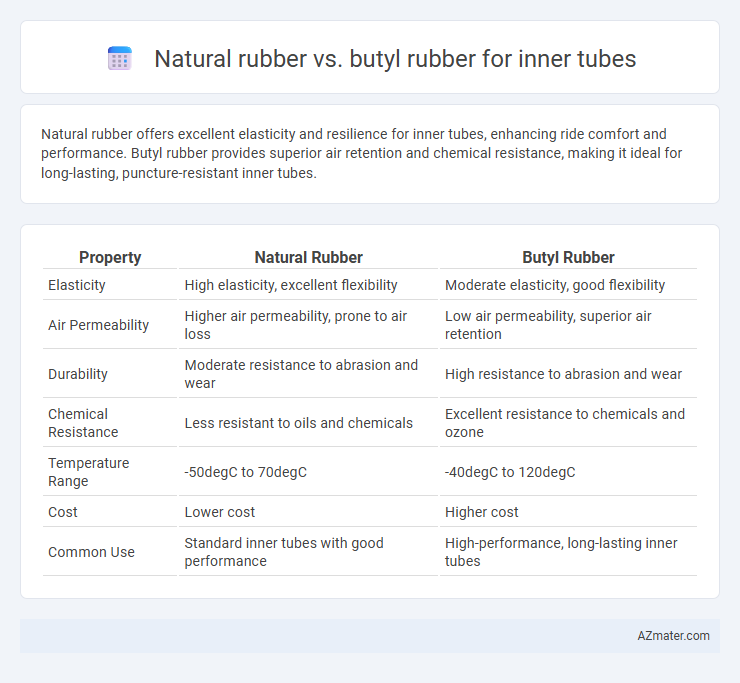Natural rubber offers excellent elasticity and resilience for inner tubes, enhancing ride comfort and performance. Butyl rubber provides superior air retention and chemical resistance, making it ideal for long-lasting, puncture-resistant inner tubes.
Table of Comparison
| Property | Natural Rubber | Butyl Rubber |
|---|---|---|
| Elasticity | High elasticity, excellent flexibility | Moderate elasticity, good flexibility |
| Air Permeability | Higher air permeability, prone to air loss | Low air permeability, superior air retention |
| Durability | Moderate resistance to abrasion and wear | High resistance to abrasion and wear |
| Chemical Resistance | Less resistant to oils and chemicals | Excellent resistance to chemicals and ozone |
| Temperature Range | -50degC to 70degC | -40degC to 120degC |
| Cost | Lower cost | Higher cost |
| Common Use | Standard inner tubes with good performance | High-performance, long-lasting inner tubes |
Introduction to Inner Tube Materials
Inner tubes commonly use natural rubber or butyl rubber, each with distinct properties suited for specific performance needs. Natural rubber offers excellent elasticity, toughness, and resistance to wear, making it ideal for applications requiring flexibility and durability. Butyl rubber provides superior air retention, chemical resistance, and impermeability, enhancing the inner tube's ability to maintain pressure over extended periods, especially in challenging environmental conditions.
What is Natural Rubber?
Natural rubber, derived from the latex of Hevea brasiliensis trees, is prized for its excellent elasticity, tensile strength, and resilience, making it a common choice in inner tube manufacturing. It offers superior air retention and flexibility but is more susceptible to degradation from ozone, heat, and chemicals compared to synthetic alternatives like butyl rubber. Natural rubber's unique molecular structure, composed primarily of cis-1,4-polyisoprene, provides natural tackiness and cushioning, essential for shock absorption in tires.
Overview of Butyl Rubber
Butyl rubber, a synthetic rubber known for its excellent impermeability to gases, is widely used in inner tubes due to its superior air retention properties compared to natural rubber. It offers enhanced resistance to heat, ozone, and aging, ensuring longer life and durability for inner tubes under various environmental conditions. While natural rubber provides greater elasticity and tear resistance, butyl rubber's low permeability and chemical stability make it the preferred material for high-performance inner tubes.
Key Differences Between Natural and Butyl Rubber
Natural rubber offers excellent elasticity, resilience, and tear resistance, making it highly suitable for inner tubes requiring superior flexibility and comfort. Butyl rubber, characterized by its superior air impermeability and chemical resistance, provides longer-lasting inflation and better resistance to ozone and weathering. While natural rubber excels in mechanical performance, butyl rubber dominates in durability and airtightness for inner tube applications.
Air Retention: Which Performs Better?
Natural rubber inner tubes exhibit excellent elasticity and air retention due to their molecular structure, allowing them to maintain pressure effectively over time. Butyl rubber inner tubes are superior in air retention compared to natural rubber because of their low gas permeability, making them ideal for prolonged inflation and minimizing frequent pumping. In applications where long-lasting air retention is critical, butyl rubber typically outperforms natural rubber, ensuring consistent tire pressure and enhanced durability.
Durability and Resistance to Wear
Natural rubber inner tubes offer excellent elasticity and good abrasion resistance, making them highly durable under typical conditions but susceptible to degradation from ozone and UV exposure. Butyl rubber inner tubes exhibit superior resistance to air permeability, ozone, and chemicals, providing longer-lasting durability and enhanced wear resistance in harsh environments. Their low gas permeability and excellent aging stability make butyl rubber the preferred choice for inner tubes requiring extended service life and robust resistance to wear.
Performance in Extreme Temperatures
Natural rubber offers superior flexibility and resilience at low temperatures, maintaining elasticity down to approximately -50degC, which prevents cracking and enhances ride comfort in cold climates. Butyl rubber excels in high-temperature resistance, sustaining performance and air retention up to 120degC due to its low permeability and excellent thermal stability. For inner tubes subjected to extreme temperature variations, combining natural rubber's cold adaptability with butyl rubber's heat resistance often yields optimal durability and safety.
Cost Comparison: Natural vs Butyl Rubber
Natural rubber inner tubes generally cost less due to the abundant availability of raw latex and lower processing expenses, making them a budget-friendly choice for many applications. Butyl rubber inner tubes, though more expensive, offer superior air retention and durability, which can reduce long-term replacement costs despite the higher initial price. The cost difference between natural and butyl rubber inner tubes reflects the balance between upfront affordability and enhanced performance characteristics.
Environmental Impact and Sustainability
Natural rubber inner tubes offer superior biodegradability due to their organic origin, significantly reducing long-term environmental pollution compared to butyl rubber. Butyl rubber, derived from synthetic polymers, is less biodegradable and often contributes to landfill waste, although it provides enhanced air retention and durability. Sustainable sourcing of natural rubber through certified plantations supports ecological balance, whereas butyl rubber's production relies on petrochemical processes with higher carbon emissions.
Which Inner Tube Material Should You Choose?
Natural rubber inner tubes offer excellent elasticity and resilience, making them ideal for bicycles and motorcycles requiring high flexibility and puncture resistance. Butyl rubber inner tubes provide superior air retention and chemical resistance, making them the preferred choice for vehicles needing long-term durability and minimal maintenance. Choosing between natural rubber and butyl rubber depends on your specific needs: select natural rubber for performance and comfort or butyl rubber for longevity and air retention.

Infographic: Natural rubber vs Butyl rubber for Inner tube
 azmater.com
azmater.com